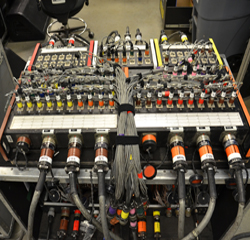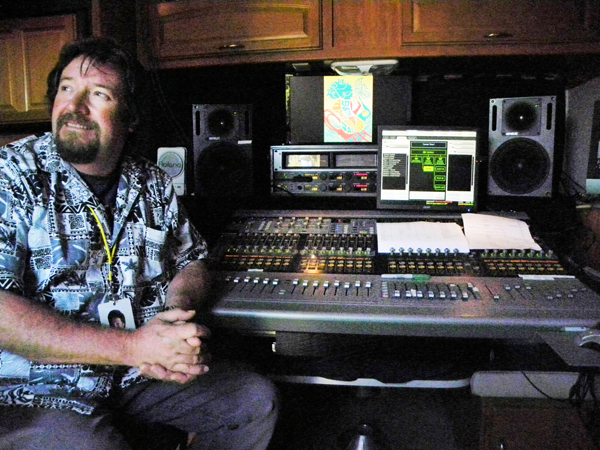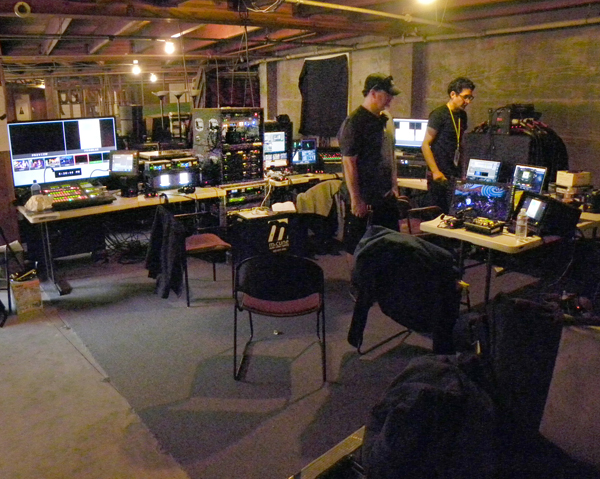
Splitting & Routing
To accommodate the different mix requirements for FOH, monitors, archiving, and simulcast, stage signals are split three ways.
Though all mixing consoles are digital, with A/D converters on stage, the split itself is analog via a custom Ramtech STGBX-54 three-way splitter. Each of the 54 channels can be input directly or via four 12-channel and one 6-channel Ramtech CPC onstage sub-snakes.
The SD10 console at FOH is directly connected, and the monitor and archiving consoles receive transformer-isolated feeds. “Any mic that’s in the system, even if it’s only for a record input, has to connect to FOH for phantom power,” adds Nick Malgieri, FOH mixer.
From the splitter, the stage signals go from each of the three multi-pin outputs to the A/D converter boxes. Both FOH and monitors use two 32-input DiGiCo D-Racks, with an optical fiber loop to transmit the signals to the consoles. To feed the Profile console for archival recording, the third split goes to a VENUE Stage Rack using MADI digital protocol. The video control area receives two separate stereo mixes, from FOH and the archival truck, and uses one or the other to embed with the live-edited video signal – which goes from there to simulcast, recording, and webcast.
On the decision to use an analog split rather than digital networking to share audio signals, Malgieri explains, “There are ways we could network it all together, but for speed and efficiency we keep it an analog split. That way, no one is tied to anyone else. Sharing preamps together would make us interdependent, which wouldn’t be conducive to a festival-style event with fast changes and guest engineers.”
Recording & Archiving
Ron Davis has been mixing and producing the Monterey Jazz archival recordings for many years. The mix is independent of FOH, starting with the raw signal “straight off the mic” plus the audience mics above the stage and in the house for crowd response. Having his own multi-channel feed from the stage allows him to “fine-tune the mix for recording purposes,” he notes, since his environment is more conducive to critical listening.

The VENUE Profile console interfaces with Pro Tools, and Rob Macky monitors the recording along with other technical details. Other members of the team include an onstage liason, who is in touch continually with a comms person in the truck (also connected with FOH, video, and other positions throughout the venue), and another who archives the recordings to digital media as soon as they’re finished.
Davis says that 48 channels are usually more than enough for the acts plus the audience mics, though at times he needs to drop a couple of inputs. In those cases, he may choose one of a stereo pair of mics or just use the DI from the bass rather than adding the mic on the cabinet. His mix is patched to the video area as a potential simulcast feed, and is fed to any radio broadcast trucks airing the show. The archival truck also receives the FOH mix for redundancy.
Monterey Jazz Simulcast
Because simulcast is an important feature at the festival, a control area is designated for video and tasked with live video for the side-stage screens, creating the simulcast feed and monitoring the venues where it plays, video archiving and performance MP4 recordings for the artists, and at times, webcasting.
The crew includes the camera operators, directed by Jesse Block from the control room, a person controlling the video and audio embedding, another on recording, and a “grounds technician.”

Simulcast receives mixes from FOH and the record truck, plus an ambient mic submix. Malgieri states that “Depending on who’s ready first, video makes a judgment depending on what’s coming down the pipe on which mix they’re going to go with. This could change for each act.” Also, having both mixes available provides a backup in case of trouble, giving the same content but different mixes.
The simulcast feed goes to the Jazz Theatre, where patrons who have purchased ground passes for the other stages can experience what’s happening on the arena stage. The signal is sent about 750 feet via fiber to the theatre, and then decoded into L/R audio to full-range loudspeakers and subwoofers, with video projected on a large screen. The Premier (VIP) Lounge is a smaller venue, closer to the arena, and it also receives the simulcast via HD/SDI.
